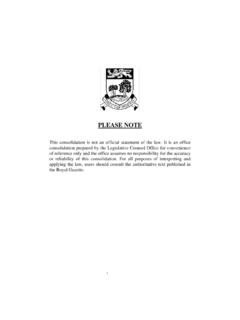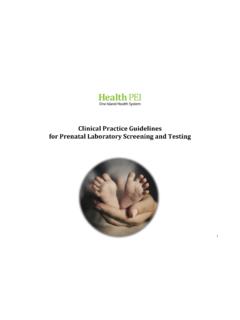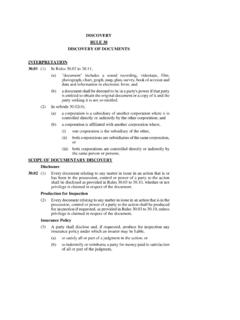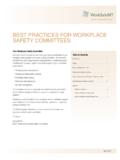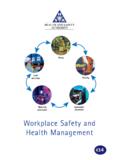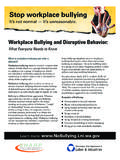Transcription of Guide to Workplace Health & Safety Programs
1 Guide to Workplace Health & Safety Programs WCB Information Series publication Revised November, 2009. Guide to Workplace Health & Safety Programs Table of Contents Introduction 2. About this Guide 2. What is an OHS Program? 2. Legal Requirement 2. Internal Responsibility System 3. Who is Responsible for the Program? 3. Getting Started 4. General Responsibilities 4. Building a Health and Safety Program from the Ground Up 5. Programs and Due Diligence 5. Legal Requirements 6. Step 1: Create a Health and Safety Policy 7. The Occupational Health & Safety Policy 7. Tips for turning your Safety policy into action 8. Step 2: Establish a JOSH Committee or a Health and Safety Representative 8.
2 The Joint Occupational Health and Safety (JOSH) Committee 8. JOSH Committee and Representative Role in Programs 9. Step 3: Establish and Record Regular Workplace Inspections 10. Workplace Inspections 10. Step 4: Incident Investigation 11. Incident Investigation 11. What About Near Misses? 12. Step 5: Creating a Hazard Identification System 12. What is a Hazard Identification System? 12. Getting Started 13. Identifying Potential Hazards 13. Step 6: Develop Written Work Procedures 15. Work Procedures 15. Writing a Safe Work Procedure 15. Work Procedures for Reporting Hazards 17. What about Emergency Procedures? 17. Step 7: Establish Training and Orientation Requirements 18.
3 Training and Orientation 18. When is Training required? 19. Is Specific Training Legislated? 20. Step 8: Establish Appropriate Levels of Supervision 20. Supervision 20. What if a Worker Refuses to Follow Safe Work Procedures? 20. Step 9: Maintain Records and Statistics 21. Records and Statistics: Evidence that the OHS Program is being used 21. Step 10: Evaluating the Program 22. Program Evaluation: Evidence that the OHS Program is effective 22. Appendix A. Draft Occupational Health And Safety Policy 24. Appendix B. Sample Workplace Inspection Report Form 25. Appendix C. Incident/Injury Investigation Report Form 26. Appendix D. Sample Critical Hazard Identification System 27.
4 Appendix E. Training Records 31. Resources For More Information 32. The Occupational Health & Safety Program: Your Recipe for a Healthier, Safer Workplace Introduction About this Guide This Guide is for employers, workers, Joint Occupational Health and Safety (JOSH) committees, and Health & Safety Representatives. It will help you prepare and maintain your written occupational Health and Safety (OHS) program. This Guide describes the elements of a formal OHS program, and the roles and responsibilities of those preparing and maintaining the program. What is an OHS Program? To create a Safety culture, you need a plan. An OHS program is an organized, written action plan to identify and control hazards, define Safety responsibilities, and respond to emergencies.
5 The objective of a program is to integrate Safety and Health into all work practices and conditions. Having a safe work environment where prevention is the key to an organization's success is important to all Workplace parties employers, workers including supervisors and managers, and JOSH Committees and Representatives. When safe work practices are a part of the everyday work routine, there are huge savings in human and financial costs to a business. Legal Requirement An OHS program is required under the Occupational Health and Safety Act for provincially- regulated employers on Prince Edward Island with 20 or more regularly employed workers. 23.(1) Where 20 or more workers are regularly employed (a) by an employer other than a constructor or contractor; or (b) directly by a constructor or contractor, the employer, constructor or contractor shall establish, and review at least annually, a written occupational Health and Safety program, in consultation with the committee or representative, if any.
6 The program requirement is tied to employers, not workplaces. Therefore, an employer who has three workplaces, with eight employees in each location, will require three different Health and Safety representatives and one overall OHS program that covers all three locations. Constructors and contractors must have a program if they have 20 or more workers directly employed. Sub-contractors and their employees working for the constructors would not be counted in the number. p. 2. This Guide will help you comply with the OHS requirements for your Workplace , but it does not replace the Occupational Health and Safety Act and Regulations. For full specific requirements related to these topics, refer to s.
7 23 of the Act. Internal Responsibility System The OHS program promotes the internal responsibility system on which the Occupational Health and Safety Act is based. Under the internal responsibility system, the people doing the work are responsible for creating a healthy and safe Workplace . No matter where or who the person is within the organization, they can address Safety in a way that fits with what they do. Every person takes initiative to improve Health and Safety on an on-going basis. The Occupational Health and Safety division cannot reasonably regulate the Safety activities of each and every Island Workplace ; therefore, the employers and workers must participate in and take responsibility for their own Safety .
8 This is done, in part, through a formal written OHS. program. Who is Responsible for the Program? A Health and Safety program must provide a clear outline of responsibility and accountability for all workers regarding Health and Safety in the Workplace . It is the employer's responsibility to develop and implement an OHS program. An effective program will help reduce injuries and costs, and will help defend an employer against any charges under the Occupational Health and Safety Act. It is the responsibility of the JOSH Committee (or Safety representative) to monitor the effectiveness of the program. Committee members are encouraged to contribute to the development of the program by conducting Workplace inspections, and making and following up on recommendations.
9 The Health and Safety Coordinator (if any) maintains the documentation, creates written work procedures with worker and committee input, and ensures training is done and records of training are kept. Safety is everyone's responsibility. p. 3. Getting Started What does an effective Occupational Health and Safety Program look like? General Responsibilities Responsibilities of workers and employers will vary depending on the industry and nature of their work. However, across all industries and sectors, there are general responsibilities expected within an OHS program at all operational levels: Position General Responsibilities Senior Management/Leadership Provide policy direction and planning Review control information Delegate responsibility and authority Allocate budget Cooperate with Safety committees and representatives Hold line managers accountable for safe production Make sure line managers have adequate resources and support Assist the Health and Safety committee or representative Line Management Train operators and others Supervise employees to ensure safe work procedures are followed correctly Communicate hazard information and control procedures Consult with employees on matters of Health and Safety Provide feedback to senior executive
10 Cooperate with the JOSH committee or representative Hold accountable those managers, supervisors, and workers reporting to them All Employees Comply with company rules and procedures Wear personal protective equipment as required Use machinery, equipment, and materials only as authorized Follow job procedures Report hazards, unsafe conditions or actions to your supervisor Report incidents Report all injuries for first aid, no matter how minor Cooperate with the JOSH committee or representative JOSH Committees Hold monthly meetings; record and post minutes Make recommendations on Health and Safety issues Carry out inspections, investigations, and direct worker Safety concerns as appropriate Assist with the development of the OHS program, the Health and Safety policy, and safe work procedures Health & Safety Representatives Make recommendations on Health and Safety issues Take employee Health and Safety concerns to management p.
